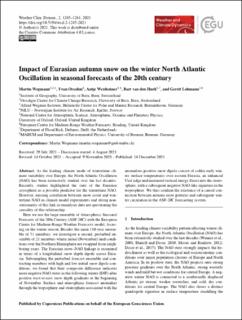| dc.contributor.author | Wegmann, Martin | |
| dc.contributor.author | Orsolini, Yvan J. | |
| dc.contributor.author | Weisheimer, Antje | |
| dc.contributor.author | Van Den Hurk, Bart | |
| dc.contributor.author | Lohmann, Gerrit | |
| dc.date.accessioned | 2022-01-18T11:43:38Z | |
| dc.date.available | 2022-01-18T11:43:38Z | |
| dc.date.created | 2021-12-20T10:14:34Z | |
| dc.date.issued | 2021 | |
| dc.identifier.citation | Weather and Climate Dynamics (WCD). 2021, 2, 1245-1261. | en_US |
| dc.identifier.uri | https://hdl.handle.net/11250/2837911 | |
| dc.description.abstract | As the leading climate mode of wintertime climate variability over Europe, the North Atlantic Oscillation (NAO) has been extensively studied over the last decades. Recently, studies highlighted the state of the Eurasian cryosphere as a possible predictor for the wintertime NAO. However, missing correlation between snow cover and wintertime NAO in climate model experiments and strong non-stationarity of this link in reanalysis data are questioning the causality of this relationship. Here we use the large ensemble of Atmospheric Seasonal Forecasts of the 20th Century (ASF-20C) with the European Centre for Medium-Range Weather Forecasts model, focusing on the winter season. Besides the main 110-year ensemble of 51 members, we investigate a second, perturbed ensemble of 21 members where initial (November) land conditions over the Northern Hemisphere are swapped from neighboring years. The Eurasian snow–NAO linkage is examined in terms of a longitudinal snow depth dipole across Eurasia. Subsampling the perturbed forecast ensemble and contrasting members with high and low initial snow dipole conditions, we found that their composite difference indicates more negative NAO states in the following winter (DJF) after positive west-to-east snow depth gradients at the beginning of November. Surface and atmospheric forecast anomalies through the troposphere and stratosphere associated with the anomalous positive snow dipole consist of colder early winter surface temperatures over eastern Eurasia, an enhanced Ural ridge and increased vertical energy fluxes into the stratosphere, with a subsequent negative NAO-like signature in the troposphere. We thus confirm the existence of a causal connection between autumn snow patterns and subsequent winter circulation in the ASF-20C forecasting system. | en_US |
| dc.language.iso | eng | en_US |
| dc.rights | Navngivelse 4.0 Internasjonal | * |
| dc.rights.uri | http://creativecommons.org/licenses/by/4.0/deed.no | * |
| dc.title | Impact of Eurasian autumn snow on the winter North Atlantic Oscillation in seasonal forecasts of the 20th century | en_US |
| dc.type | Peer reviewed | en_US |
| dc.type | Journal article | en_US |
| dc.description.version | publishedVersion | en_US |
| dc.rights.holder | © Author(s) 2021. | en_US |
| dc.source.pagenumber | 1245-1261 | en_US |
| dc.source.volume | 2 | en_US |
| dc.source.journal | Weather and Climate Dynamics (WCD) | en_US |
| dc.identifier.doi | 10.5194/wcd-2-1245-2021 | |
| dc.identifier.cristin | 1970395 | |
| dc.relation.project | NILU - Norsk institutt for luftforskning: 120026 | en_US |
| cristin.ispublished | true | |
| cristin.fulltext | original | |
| cristin.qualitycode | 1 | |

